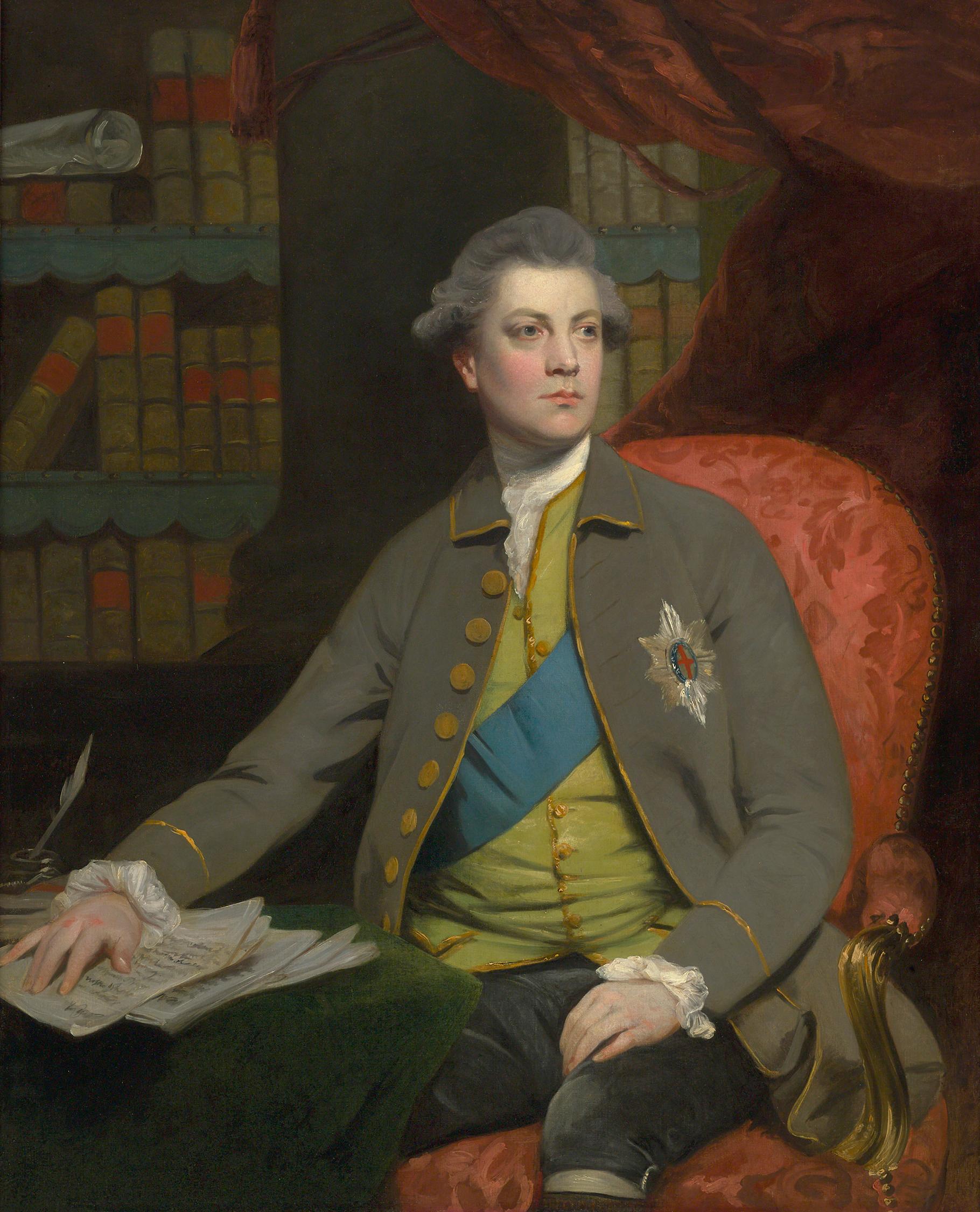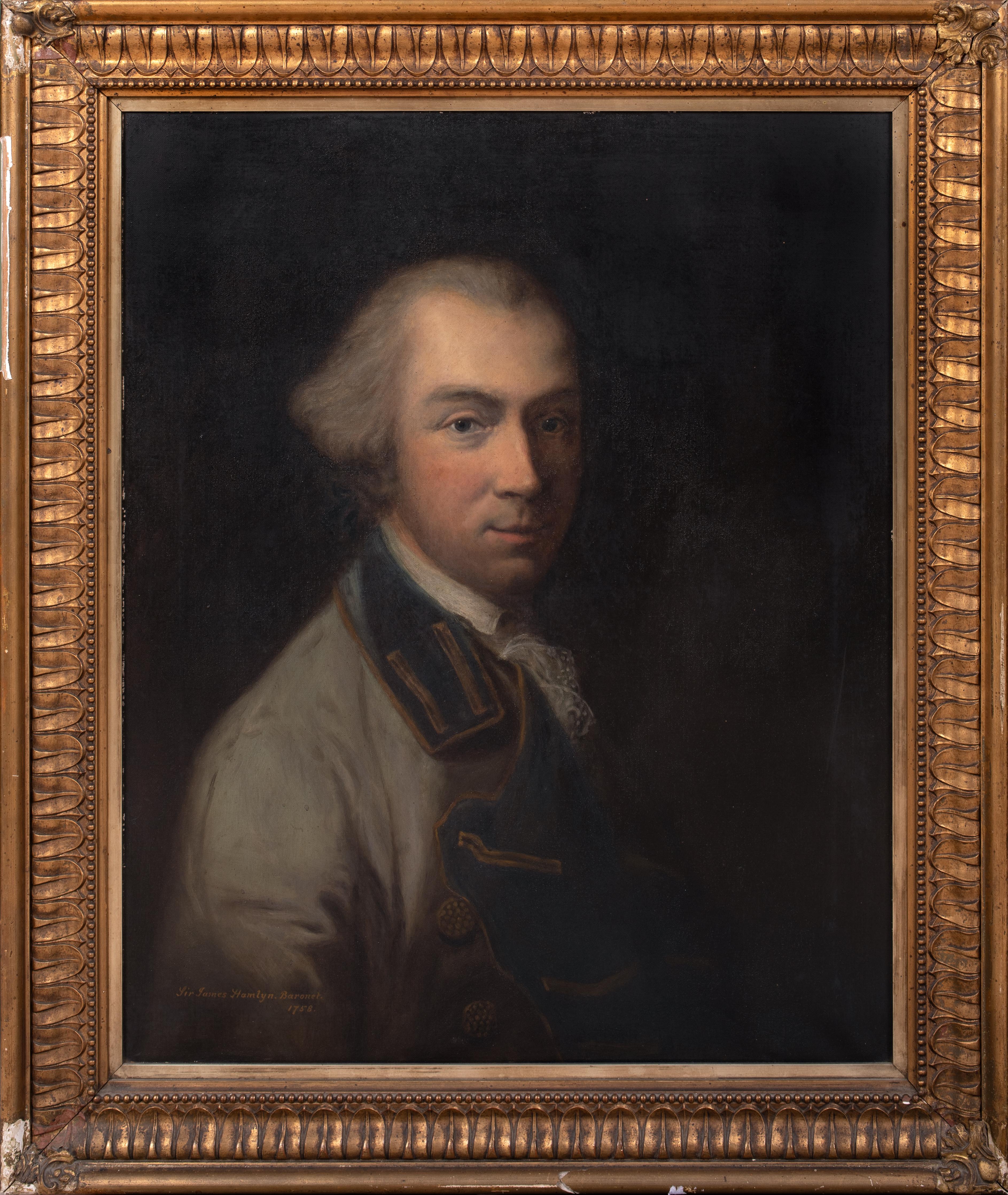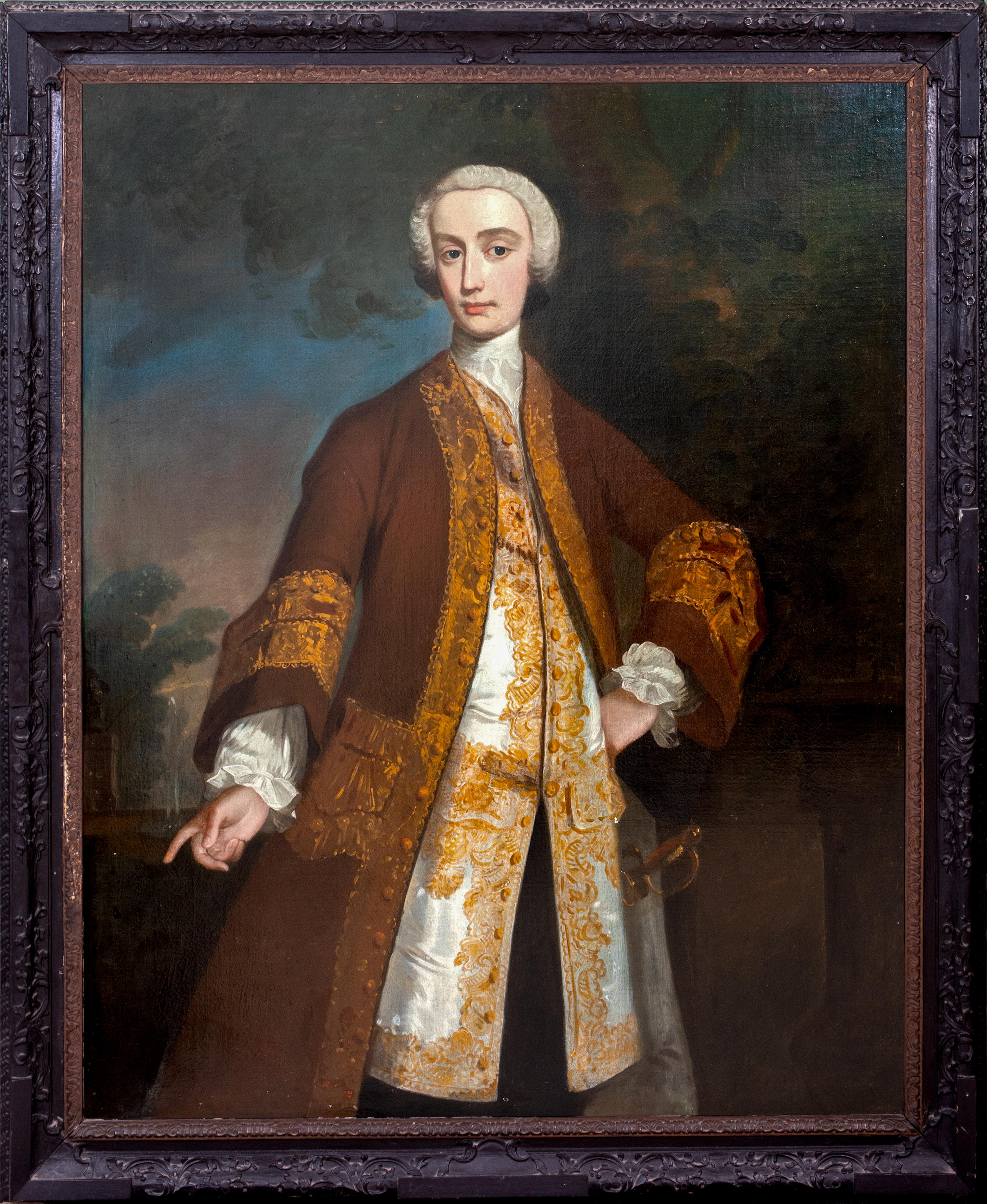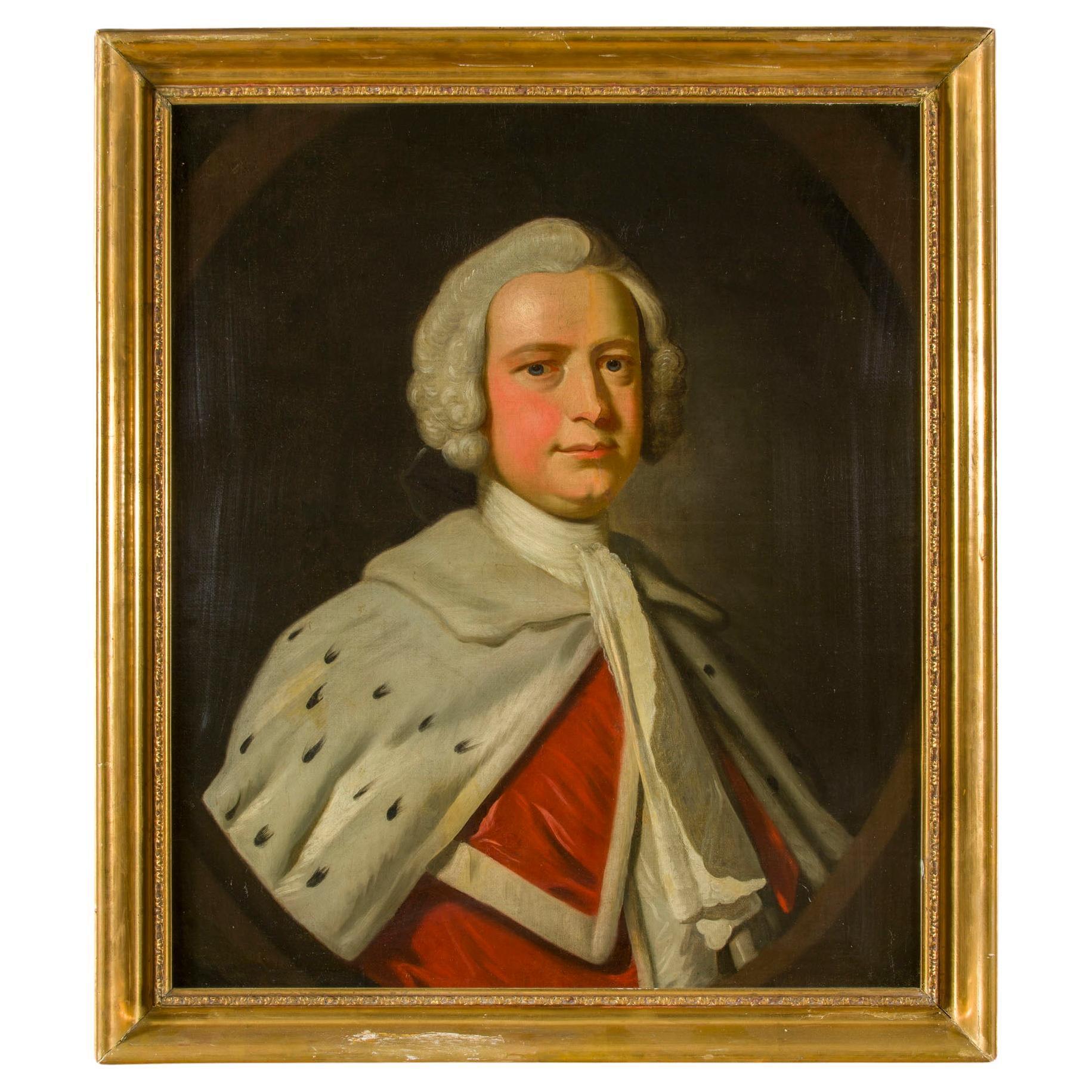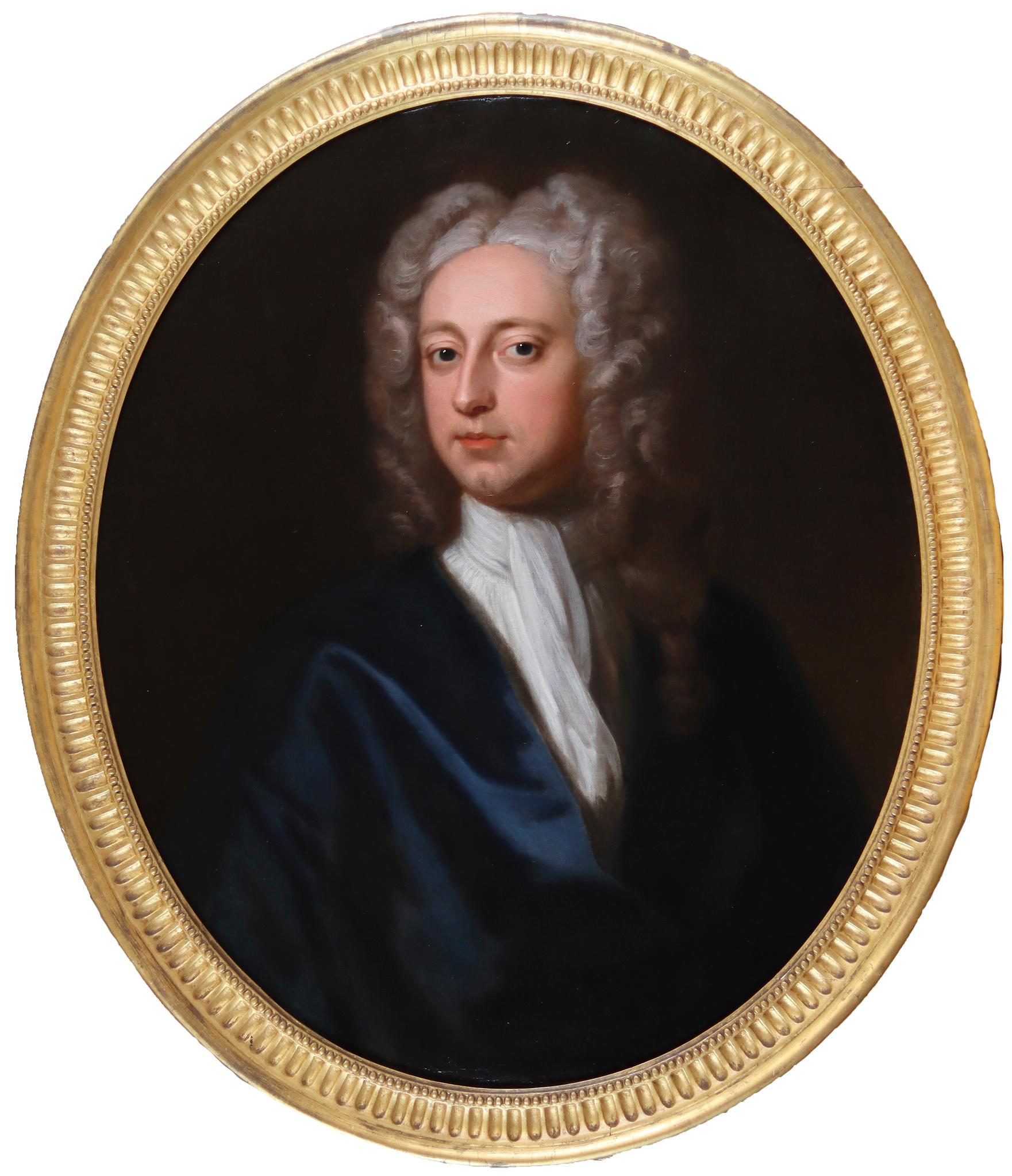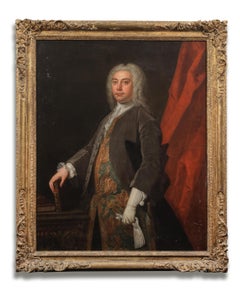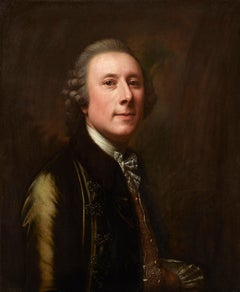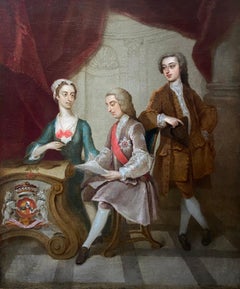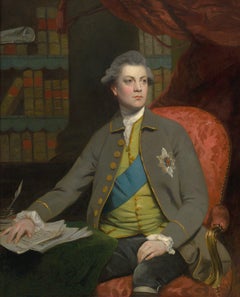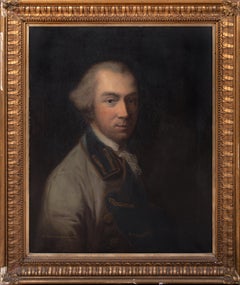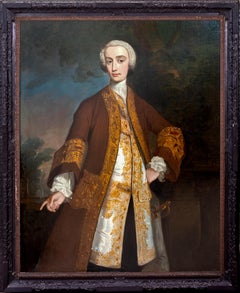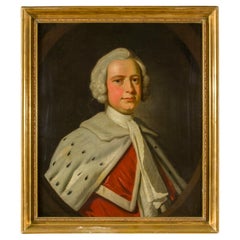Items Similar to Portrait of William Henry Kerr, Earl of Ancram, 4th Marquess of Lothian
Want more images or videos?
Request additional images or videos from the seller
1 of 9
James FellowesPortrait of William Henry Kerr, Earl of Ancram, 4th Marquess of Lothian1747
1747
$16,543.34
£12,000
€14,012.95
CA$22,874.11
A$25,112.91
CHF 13,101.46
MX$303,901.23
NOK 164,206.48
SEK 154,725.68
DKK 104,602.93
About the Item
James Fellowes
Flourished 1719 - 1750
Portrait of William Henry Kerr, Earl of Ancram, 4th Marquess of Lothian
Oil on canvas, signed & dated 1747
Image size: 29 1/2 x 24 1/2 inches (75 x 62 cm)
Original gilt wood frame
William Henry Kerr was born a member of the Scottish peerage to William, third Marquess of Lothian, and his first wife Margaret, daughter of Sir Thomas Nicholson of Kemnay, first Baronet. William was styled Master Jedburgh until 1722, when his father was elevated to a Marquessate, after which he was referred to as Lord Jedburgh until 1735. Following his father’s military footsteps, on 20 June 1735 Ancram was commissioned as a cornet to the regiment (11th Dragoons) of his grand-uncle, Lord Mark Kerr. Ancram married Lady Caroline D’Arcy, only daughter of Robert, third Earl of Holdernesse, in November of 1735 and upon his marriage, he assumed the title of Earl of Ancram. Lady Caroline brought a sum of £20,000 the marriage and the couple had three children: William John, 5th Marquess of Lothian; Louisa, who would marry Lord George Henry Lennox and Willielmina, who would marry Colonel John Macleod. Ancram became Captain of the 11th Foot in Cornwallis on 9 January 1739 and was later promoted to Captain and Lieutenant Colonel of the first Regiment of Foot Guards in 1741.
At the battle of Fontenoy on 30 April 1735, Ancram acted as aide-de-camp to the Duke of Cumberland, where he was injured by a musket ball to the head. Nevertheless, this temporary setback did not hinder Ancram’s military career. He was promoted to the rank of Colonel on 4 June 1745 and returned to the 11th Dragoons after being promoted to Lieutenant Colonel on 22 June. He was Commander of the Calvary of the left wing during the Battle of Culloden on 16 April 1746. His orders were to stand ready to pursue the highland army, which was anticipated to break apart and retreat. The pursuit resulted in slaughter. During this battle Ancram’s younger brother, Lord Robert, was killed when his regiment faced the brunt of the highland charge.
Following the English victory at Culloden, Ancram was placed in command of forces in Aberdeen and the East Coast of Scotland in order to suppress lingering Jacobite revolts. In a letter to the Duke of Newcastle dated March 1746, the Duke of Cumberland explained how he dispatched Ancram from Aberdeen with 100 Dragoons and 300 Foot to Castle Corgaff to take a “quantity of Spanish arms and powder”. The Jacobites fled upon seeing his approach and Ancram was able to take the castle without resistance. Upon reaching the castle, the English found the munitions had already been destroyed. In his letter the Duke of Cumberland commended Ancram’s actions, stating he “behaved with the greatest prudence and caution, and much like an Officer”. This portrait depicts Ancram as an Aide-de-Camp to the Duke around this time. He was then appointed Colonel of the 24th Foot on 1 December 1747.
Upon his return, Ancram was elected to Parliament as the representative for Richmond in 1747. He was re-elected in 1754. Although he served as a Member of Parliament, Ancram continued his career in the military and became Colonel of the 11th Dragoons on 8 February 1752. He was promoted to Major General in 1755 and served as Lieutenant General under Charles Spencer, third Duke of Marlborough, in the 1758 St. Malo expedition. In the House of Commons, Ancram followed the Duke of Cumberland’s political agenda, which meant opposing the negotiations of the Treaty of Paris. In 1762, Ancram’s brother-in-law sold the Earl’s Richmond seat to Sir Lawrence Dundas, which put Ancram in an awkward position. The Earl remained in the House during the December vote on the peace preliminaries, which he voted against having missed the message from the Duke of Cumberland telling him to refrain from doing so. After this incident, Ancram resigned his seat in Parliament for £4,000.
Ancram’s father passed away on 28 July 1768, thus allowing Ancram to claim the title of 4th Marquess of Lothian. Soon after, he was elected a Scottish Representative Peer on 26 October 1768 and was inducted into the Order of the Thistle at St. James Palace on this same day. He received his final military promotion to General in 1770 and passed away five years later on 12 April 1775 in Bath.
In this portrait Ancram is depicted in his role of Aide du Campe to the Duke of Cumberland, with aiguillettes of gold wire cord on his right shoulder. This was a very high-ranking role, as the aide-de-camp is typically the foremost personal aide. The court list showing the Household of the Duke of Cumberland has Ancram as a Gentleman of the Bedchamber in the following year, for which he was paid £400 per annum.
James Fellowes was a provincial portrait painter working in the style of Enoch Seeman (1694 - 1744). He was active in Cheshire and the North-west. His latest known dated portraits were painted 1751. He usually signed and dated his works on the back, which of course would be obscured by re-lining.
Fellowes paintings were engraved by George Vertue.
Art Galleries
Manchester City Art Gallery, Portsmouth Museum, Darnley Fine Art and the British Museum.
- Creator:James Fellowes (1719 - 1751, English)
- Creation Year:1747
- Dimensions:Height: 29.5 in (74.93 cm)Width: 24.5 in (62.23 cm)
- More Editions & Sizes:1 of 1Price: $16,543
- Medium:
- Movement & Style:
- Period:1740-1749
- Condition:
- Gallery Location:London, GB
- Reference Number:1stDibs: LU5248428782
About the Seller
5.0
Vetted Professional Seller
Every seller passes strict standards for authenticity and reliability
Established in 2007
1stDibs seller since 2014
82 sales on 1stDibs
Typical response time: 4 hours
- ShippingRetrieving quote...Shipping from: London, United Kingdom
- Return Policy
Authenticity Guarantee
In the unlikely event there’s an issue with an item’s authenticity, contact us within 1 year for a full refund. DetailsMoney-Back Guarantee
If your item is not as described, is damaged in transit, or does not arrive, contact us within 7 days for a full refund. Details24-Hour Cancellation
You have a 24-hour grace period in which to reconsider your purchase, with no questions asked.Vetted Professional Sellers
Our world-class sellers must adhere to strict standards for service and quality, maintaining the integrity of our listings.Price-Match Guarantee
If you find that a seller listed the same item for a lower price elsewhere, we’ll match it.Trusted Global Delivery
Our best-in-class carrier network provides specialized shipping options worldwide, including custom delivery.More From This Seller
View AllPortrait of Ralph William Grey
By Bartholomew Dandridge
Located in London, GB
Provenance
By descent through the sitter's family to
The Collection of R. W. Vivian-Neal of Poundisford Park, Somerset, from whom acquired by
With Lane Fine Art, UK, where purchased by the present owners in 1996
Literature
'Poundisford Park, Somerset' in Country Life, 22 December 1934, ill.
A.W. and C.M. Vivian-Neal, Poundisford Park, Somerset: A catalogue of pictures and furniture, Taunton 1939, cat. nos. 11 and 13
This is a three-quarter-length portrait of Ralph William Grey in a mole-coloured velvet coat and a long waistcoat of green satin, heavily embroidered in gold. Under his left right hand is a black chapeau bras. He has white doe-skin gauntlet gloves.
Son of William and Ann Grey of Backworth: born 19 December 1707. He married Mary the daughter of William Rawstorne of Newall in 1741 and died 5 November 1786. He was educated at Eaton and Trinity College, Oxford.
Within a year of his birth Mrs Grey died and, according to the Country Life article 'From that time forward all Mr Grey's faculties were concentrated on the well-being of his son. The possession of an heir gave zest to his efforts to build up the family fortune: he was successful in most of his ventures. Years later his interest in life was centred in the home of his daughter-in-law and grandchildren'.
Grey's right hand is depicted in the present portrait resting on Locke's Essays and the Country Life article also records that there are constant references to John Locke...
Category
Mid-18th Century English School Portrait Paintings
Materials
Oil
Portrait of a Gentleman, 18th Century Oil Painting
By Anton von Maron
Located in London, GB
Oil on canvas
Image size: 20 x 24 inches (51 x 61 cm)
Period gilt frame
This is a half-length portrait of a gentleman wearing a emerald coat and intricately designed waistcoat, dat...
Category
1760s Portrait Paintings
Materials
Canvas, Oil
Portrait of William Herbert, 3rd Earl of Pembroke, Early 17th Century Portrait
Located in London, GB
English School, (circa 1600)
Portrait of William Herbert, 3rd Earl of Pembroke
Oil on panel, oval
Image size: 29¼ x 23⅞ inches
Painted wooden frame
Provenance:
176, Collection of Francis Greville, 1st Earl of Warwick.
The Trustees of the Lord Brooks’ Settlement, (removed from Warwick Castle).
Sotheby’s, London, 22nd March 1968, lot 81.
Painted onto wooden panel, this portrait shows a dark haired gentleman in profile sporting an open white shirt. On top of this garments is a richly detailed black cloak, decorated with gold thread and lined with a sumptuous crimson lining. With the red silk inside it’s all very expensive and would fall under sumptuary laws – so this is a nobleman of high degree.
It’s melancholic air conforms to the contemporary popularity of this very human condition, evident in fashionable poetry and music of the period. In comparison to our own modern prejudices, melancholy was associated with creativity in this period.
This portrait appeared in the earliest described list of pictures of Warwick castle dating to 1762. Compiled by collector and antiquary Sir William Musgrave ‘taken from the information of Lord & Lady Warwick’ (Add. MSS, 5726 fol. 3) is described;
‘8. Earl of Essex – an original by Zuccharo – seen in profile with black hair. Holding a black robe across his breast with his right hand.’
As tempting as it is to imagine that this is a portrait of Robert Devereux, the 2nd Earl Essex, we might take this with a pinch of salt. Its identification with this romantic and fatal Elizabethan might well have been an attempt to add romance to Warwick Castle’s walls. It doesn’t correspond all that well with Essex’s portraits around 1600 after his return from Cadiz. Notably, this picture was presumably hung not too far away from the castle’s two portraits of Queen Elizabeth I. The first, and undoubtedly the best, being the exquisite coronation portrait that was sold by Lord Brooke in the late 1970s and now hangs in the National Portrait Gallery. The second, described as being ‘a copy from the original at Ld Hydes’, has yet to resurface.
The portrait eventually ended up being hung in the State Bedroom of Warwick Castle.
Archival documents present one other interesting candidate. The Greville family’s earliest inventory of paintings, made in 1630 at their home Brooke House in Holborn, London, describes five portraits of identified figures. All five belonged to the courtier, politician and poet Sir Fulke Greville (1554-1628), 1st Baron Brooke, and were hung in the ‘Gallerie’ of Brooke House behind yellow curtains. One of them was described as being of ‘Lord of Pembrooke’, which is likely to have been William Herbert (1580-1630), 3rd Earl of Pembroke. William was the eldest son of Greville’s best friend’s sister Mary Sidney, and was brought up in the particularly literary and poetically orientated household which his mother had supported. Notably, the 3rd Earl was one of the figures that Shakespeare’s first folio was dedicated to in 1623.
The melancholic air to the portrait corresponds to William’s own pretensions as a learned and poetic figure. The richness of the robe in the painting, sporting golden thread and a spotted black fabric, is indicative of wealth beyond that of a simple poet or actor. The portrait’s dating to around the year 1600 might have coincided with William’s father death and his own rise to the Pembroke Earldom. This period of his life too was imbued with personal sadness, as an illicit affair with a Mary Fitton had resulted in a pregnancy and eventual banishment by Elizabeth I to Wilton after a short spell in Fleet Prison. His illegitimate son died shortly after being born. Despite being a close follower of the Earl of Essex, William had side-stepped supporting Devereux in the fatal uprising against the Queen and eventually regained favour at the court of the next monarch James I.
His linen shirt is edged with a delicate border of lace and his black cloak is lined on the inside with sumptuous scarlet and richly decorated on the outside with gold braid and a pattern of embroidered black spots.
Despite the richness of his clothes, William Herbert has been presented in a dishevelled state of semi-undress, his shirt unlaced far down his chest with the ties lying limply over his hand, indicating that he is in a state of distracted detachment. It has been suggested that the fashion for melancholy was rooted in an increase in self-consciousness and introspective reflection during the late 16th and early 17th centuries.
In contemporary literature melancholy was said to be caused by a plenitude of the melancholy humor, one of the four vital humors, which were thought to regulate the functions of the body. An abundance of the melancholia humor was associated with a heightened creativity and intellectual ability and hence melancholy was linked to the notion of genius, as reflected in the work of the Oxford scholar Robert Burton, who in his work ‘The Anatomy of Melancholy’, described the Malcontent as ‘of all others [the]… most witty, [who] causeth many times divine ravishment, and a kind of enthusiamus… which stirreth them up to be excellent Philosophers, Poets and Prophets.’ (R. Burton, The Anatomy of Melancholy, London, 1621 in R. Strong, ‘Elizabethan Malady: Melancholy in Elizabethan and Jacobean Portraits’, Apollo, LXXIX, 1964).
Melancholy was viewed as a highly fashionable affliction under Elizabeth I, and her successor James I, and a dejected demeanour was adopted by wealthy young men, often presenting themselves as scholars or despondent lovers, as reflected in the portraiture and literature from this period. Although the sitter in this portrait is, as yet, unidentified, it seems probable that he was a nobleman with literary or artistic ambitions, following in the same vain as such famous figures as the aristocratic poet and dramatist, Edward de Vere...
Category
Early 17th Century Old Masters Portrait Paintings
Materials
Oil, Wood Panel
William, 1st Viscount Bateman and Family
Located in London, GB
Oil on canvas
Image size: 24 x 18 1/2 inches (61 x 47 cm)
Gilded wood framed
Provenance
Estate of Judge Davis Norton and Florence Edelstein.
William Bateman was a British Whig politician who sat in the House of Commons between 1721 and 1734. He was made Knight Companion of the Order of the Bath...
Category
Early 18th Century Figurative Paintings
Materials
Canvas, Oil
Portrait of a King's Messenger, 18th Century English Artist, Original Frame
By Charles Philips
Located in London, GB
Charles Philips
1703 - 1747
Portrait of a King's Messenger
Oil on canvas
Image size: 35 ¾ x 28 inches
Original gilt frame
King's Messenger
The job of a King's Messenger was that of a diplomatic courier, hand-carrying important and secret documents around the world. Some say that the history of the sovereigns' messengers goes back to 1199, but the first known messenger was John Norman, who in 1485 earned 4d (1½ pence) per day for carrying the state papers of Richard III.
The silver greyhound on the messenger's badge dates back to Charles II. In 1660, during his exile at Breda, Netherlands, Charles II issued a declaration of amnesty to all those who had opposed him and his father. He used messengers to make his intentions known. In answer to the messenger's question "How will they know me?", Charles reached forward to a silver bowl on the table in front of him. This bowl, with four decorative greyhounds standing proud above the rim, was well known to all courtiers. Charles broke off a greyhound and gave it to the messenger as a guarantee that the message came from him. From that date, the King's Messenger always wore a silver greyhound around his neck.
Later, dating from George II or III, a badge with the Royal Arms in enamel, with the greyhound suspended beneath, was worn. A George III example of the King's Messenger Badge, pre 1800, sold for over £30,000 pounds some years ago.
The silver greyhounds were minted for each new reign, except the brief one of King Edward VIII. The sovereign's messengers were originally controlled by the Lord Chamberlain, being Messengers of the Great Chamber. When the Foreign Office was created in 1782, the messengers remained common to the three Secretaries of State.
Charles Philips was an English artist known for painting a number of portraits and conversation pieces for noble and Royal patrons in the mid-eighteenth century.
Philips was baptised in the combined parish of St Mildred, Poultry with St Mary...
Category
18th Century Portrait Paintings
Materials
Canvas, Oil
Portrait of a Gentleman
Located in London, GB
Oil on canvas
Image size: 17 x 23 1/2 inches (43 x 60 cm)
Contemporary William Kent hand made frame
Category
18th Century Portrait Paintings
Materials
Canvas, Oil
You May Also Like
Henry Bowles Howard, 12th Earl Of Suffolk And 5th Earl Of Berkshire
Located in New Orleans, LA
Sir Joshua Reynolds
1723-1792 British
Sir Henry Bowles Howard, 12th Earl of Suffolk and 5th Earl of Berkshire
Oil on canvas
Sir Joshua Reynolds is unequivocally considered the most important English portraitist of the 18th century who was instrumental in adapting the Grand Manner style in the portrait genre. In fact, when the Royal Academy was founded in 1768, Reynolds was elected its first President, setting the precedent of quality for which all other portraitists would strive.
Reynolds's portrait of Henry Bowles Howard, 12th Earl of Suffolk, showcases his genius in the genre and mastery over the medium. Reynolds’s portrait of the Earl expertly invokes classical values with strong lighting, rich colors and expert attention to detail to help underscore the prominence and revered echelon of the sitter. Howard was an esteemed British politician and Knight of the Garter. He served as Secretary of State for the Northern Department from 1771 to 1779, and he played a key role in utilizing mercenaries during the American Revolution and safeguarding Sweden's independence.
The portrait employs Reynolds's signature style to render Howard rightfully as a gentleman of distinction. Captured seated in a stately library, the Earl appears learned and austere as he places one hand upon a stack of important documents and looks wistfully into the distance. Reynolds makes these compositional choices decisively, as the seated position gives Howard a weighty appearance of importance and the semi-profile turn captures his countenance at an attractive angle that highlights his strong, masculine features. The work draws on the classical conventions of Greek and Roman art and the Italian Renaissance masters, anchoring the nobleman in a history of refinement. Everything from his strong yet welcoming expression to his pale face enlivened by a rush of blood to the cheeks presents the picture of a strong, vital and powerful leader.
As the first president of the Royal Academy in London, Reynolds’s commissions raised the status of an artist in Britain during the Romantic period and also established the portrait as an esteemed high art genre that garnered equal import to the history paintings that reigned supreme in decades prior. Today, Reynolds’s works grace the walls of the most important museums in the world, including the Louvre, the Metropolitan Museum of Art, and the National Gallery in London, among others.
Circa 1770
Canvas: 50 1/2" high x 40 1/4" wide
Framed: 61" high x 52 1/2" wide x 3 1/2" deep
Provenance:
Sir Henry Howard, 12th Earl of Suffolk and 5th Earl of Berkshire, 1739-1779
His mother, Lady Mary Howard, née Finch, Lady Andover, d. 1803
Acquired by descent to her daughter, Frances, and her husband Richard Bagot (later Howard)
Acquired by descent to their daughter, Mary (1784-1877), and her husband Col. Fulke Greville Upton (later Howard), d. 1846
Acquired by descent to Lieutenant Colonel H.R.G. Howard
Sale, Christie's, London, March 24, 1961, no. 29
Julius Weitzner, London and New York
Sale, Paris, Musée Galliéra, December 7, 1965, no. 165
Newhouse Galleries, New York, NY
Mr. and Mrs. F. Howard Walsh, Fort Worth, Texas, 1966
Walsh Family Art Trust
Private collection, Oregon
M.S. Rau, New Orleans
Exhibited:
British Institution, London, 1844, no. 130, loaned by the Hon. Fulke Greville Howard.
South Kensington, "Second special exhibition of National Portraits," 1867, no. 478, lent by the Hon. Mrs. Greville.
Agnew's, London, 1903, no. 17.
Literature:
Algernon Graves and W. V. Cronin, A History of the Works of Sir Joshua Reynolds, P.R.A., vol. 3 (London, 1899), p. 945.
David Mannings...
Category
18th Century Other Art Style Portrait Paintings
Materials
Canvas, Oil
Portrait Of Sir James Hamlyn (1735-1811), MP for Carmarthen, Sheriff of Devon
By Joshua Reynolds
Located in Blackwater, GB
Portrait Of Sir James Hamlyn (1735-1811), MP for Carmarthen, Sheriff of Devon, 18th Century
follower of Sir Joshua REYNOLDS (1723-1792)
Large 18th Century portrait of Sir James Ham...
Category
18th Century Portrait Paintings
Materials
Canvas, Oil
Portrait Of 1st Baron Hawkstone, Sir Rowland Hill, Tory MP for Lichfield
By Charles Jervas
Located in Blackwater, GB
Portrait Of 1st Baron Hawkstone, Sir Rowland Hill, Tory MP for Lichfield (1705-1783)
by Charles JERVAS (1675-1739)
Large 18th Century portrait of Baron Hawkstone, Sir Rowland Hill,...
Category
18th Century Portrait Paintings
Materials
Canvas, Oil
Thomas Hudson Style 18th Century English Portrait
By Thomas Hudson
Located in Roma, IT
Important English school painting in the style of the great artist Thomas Hudson (Devonshire 1701 - Twickenham 1779)
It depicts the portrait of Harry Gray (1715-1768), 4th Earl of St...
Category
1750s Old Masters Portrait Paintings
Materials
Canvas, Oil
Old Master Portrait of a Gentleman - British 18th century oil painting
By Michael Dahl
Located in Hagley, England
This stunning 18th century Old Master portrait oil painting is attributed to Swedish born, England based artist Michael Dahl. Painted circa 1690 it is a sumptuous half length portrai...
Category
17th Century Old Masters Portrait Paintings
Materials
Oil
$10,435 Sale Price
20% Off
Portraits of John Wood of Hollin Hall, Yorkshire; and Francis Wood (pair)
Located in West Sussex, GB
A Superb pair of oval portraits with full provenance .Portrait of John Wood Esq of Hollin Hall, Yorkshire; Portrait of Francis Wood. Circa 1710.
Oils on canvas:29 x 24 in. Frame: 37...
Category
Early 18th Century Old Masters Portrait Paintings
Materials
Oil
More Ways To Browse
Earl Of
Portrait Of A Lady Spain
George Vertue
Antique Musket
Antique Cornets
Antique Jacobite
Duke Of Cumberland
Duke Of Newcastle
Lady Caroline
James Kerr Painting
William Henry Earl
Mary Of Modena
Mary Richardson
Maurice Schelck
Michael George Acrylic
Nadine De Rothschild
Nasser Ovissi
Oil Painting Abraham Lincoln
